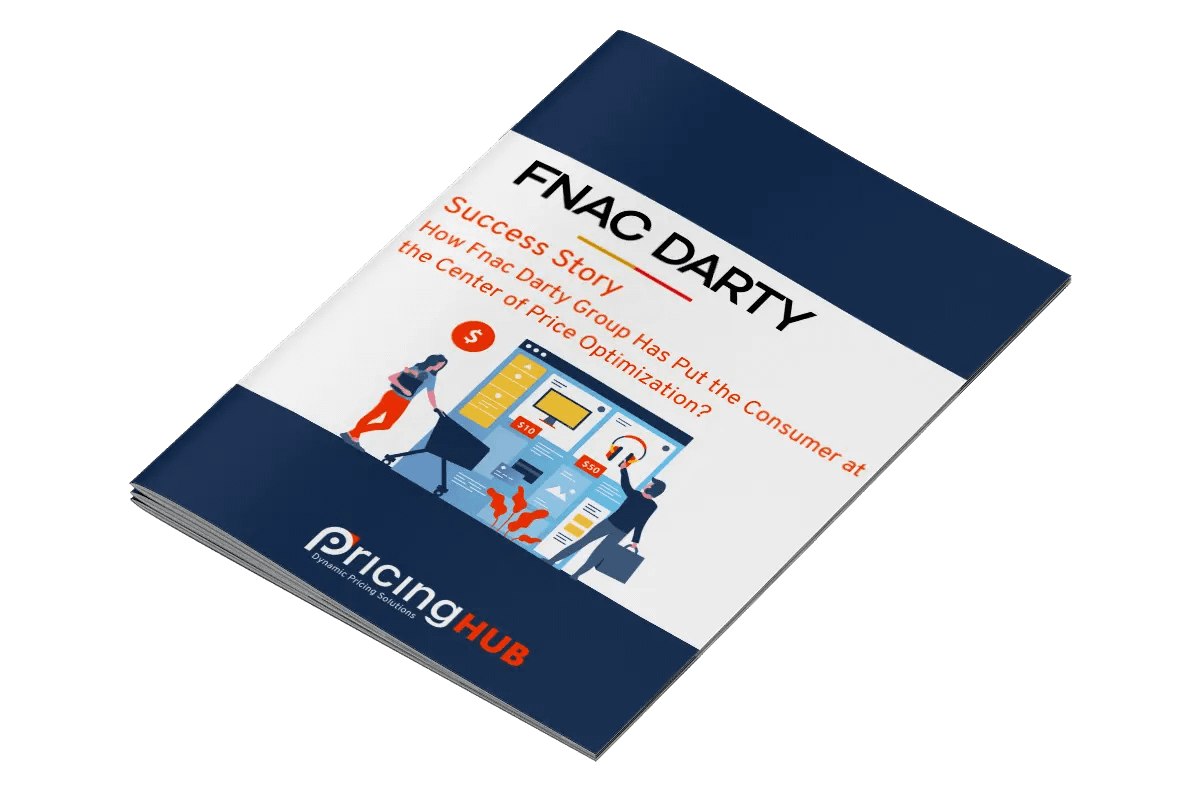In the fast-paced landscape of today’s business world, staying ahead of the competition requires innovative strategies. One such groundbreaking approach is Dynamic Pricing, a game-changer fueled by the power of Artificial Intelligence (AI). At PricingHUB, we explore the significance of Dynamic Pricing and how it has become a linchpin for businesses aiming to thrive in competitive markets, with a focus on PricingHub’s pioneering Dynamic Pricing Solutions. TL;DR A dynamic pricing strategy adjusts prices in real-time based on market demand, competition, and customer behavior. This approach helps businesses maximize revenue, improve competitiveness, and respond quickly to market changes through data-driven automation. Dynamic Pricing is a strategic approach that involves the continuous adjustment of product or service prices based on real-time changes in market conditions, demand fluctuations, and various influencing factors. This adaptive strategy ensures that prices remain competitive and responsive to current market dynamics. For these reasons, it makes dynamic pricing a key strategy for retailers in 2025 to improve their performance. The Dynamic Pricing strategy is not a one-size-fits-all solution but rather a flexible methodology that allows businesses to tailor their pricing strategies dynamically. By embracing real-time adjustments, companies can proactively respond to market changes, gaining a significant competitive advantage, as stated by Bain. “While few companies have mastered dynamic pricing, it is one of the strongest predictors of success in a select set of industries. Moreover, companies that don’t currently engage in dynamic pricing should at least lay the groundwork, as the practice has been spreading” This concept is applied in particular in the world of e-commerce, but is not limited to this sector. In fact, the Internet makes it easier to vary the prices of products or services offered by a brand, and many companies have already resorted to this practice. To cite a common example, think of the airlines, which have always varied their prices according to demand, destination, time of year and how far in advance they buy their tickets. Dynamic pricing isn’t confined to a specific field either. Hotels, air or rail transport, events, car rental, etc.: this pricing strategy can prove useful, whatever the field in which your company operates. Artificial Intelligence serves as the backbone of a Dynamic Pricing Strategy, employing advanced algorithms to analyze extensive datasets swiftly. The ability to process and interpret vast amounts of information in real-time is crucial for businesses seeking to make informed pricing decisions. AI algorithms go beyond traditional pricing models, identifying patterns and making predictive adjustments based on a myriad of factors. This not only ensures accuracy but also provides businesses with the agility needed to respond swiftly to evolving market dynamics. Dynamic Pricing equips businesses to swiftly adapt to market fluctuations and changing consumer behaviors. This adaptability allows for immediate adjustments in response to shifts in demand, competitive pricing changes, or other market variables, ensuring a sustained competitive edge. The ability to adapt in real-time is particularly crucial in industries where consumer preferences and demand patterns are subject to rapid changes. By staying ahead of these shifts, businesses can optimize their pricing strategies to meet customer expectations effectively. The use of our Pricing Solution can help you adapt your prices in real-time. Leveraging real-time data insights, Dynamic Pricing strategies optimize profit margins while potentially boosting sales volumes. Aligning prices with consumer demand enhances customer satisfaction and loyalty, thereby driving revenue growth. The dynamic nature of pricing enables businesses to strike the right balance between maximizing profit margins and offering competitive prices. By aligning pricing with customer expectations, businesses can create a win-win scenario, enhancing their financial performance. Integrating Dynamic Pricing requires a strategic approach encompassing comprehensive data evaluation, formulation of adaptable pricing algorithms, seamless integration of monitoring systems, and the establishment of automated pricing rules based on identified metrics. Implementing Dynamic Pricing is a multifaceted process. Before applying a dynamic pricing strategy to your business, it’s important to define your objectives so you know which direction to take. In fact, it’s vital to define your company’s objectives according to your KPI’s, but also your sector, as all these parameters strongly influence pricing optimization decisions. To adapt this strategy over time, set up regular monitoring with alerts on your competition and on external events that could influence your business. Use a specialized platform like PricingHUB to make your dynamic pricing effective. Customer segmentation is one of the best ways of defining a pricing grid. This enables you to identify which customers buy when, and whether your clientele is predominantly made up of private individuals or professionals. Prior research into your customers’ behavior will help you segment your clientele. You can then define prices adapted to each of these segments. And don’t forget to define refund, cancellation and other conditions once you’ve set your prices. Of course, the study of the competition is essential in the implementation of a dynamic pricing strategy, since many factors such as price variations and their frequency are impacted by the state of the competition. Once you’ve identified your competitors and analyzed their dynamic pricing strategy, you’ll have a model on which to base your own strategy. Keep in mind that a good pricing strategy is based on adaptability. Don’t be afraid to modify it over time by analyzing your results. You can also base your strategy on the seasonality of sales, by identifying sales peaks and the events that have caused these disparities. Take the time to study whether your customers buy your products or services in advance (one year, one month, etc.). Each of these elements has a considerable impact on your pricing strategy. It’s important that you take into account your sales history to analyze your customers’ behavior and to spot repetitive patterns. This will enable you to draw behavioral cycles and highlight periods of high and low activity. In this way, your data is your best resource for better understanding your business. Implementation challenges may revolve around ensuring data accuracy, addressing system integration complexities, and managing internal resistance to change. Overcoming these hurdles demands meticulous planning, effective communication, and phased implementation strategies. Resistance to change is a common challenge when introducing Dynamic Pricing, as it may disrupt existing processes and workflows. Communicating the benefits of Dynamic Pricing and involving key stakeholders in the implementation process can help mitigate resistance and ensure a smoother transition. Meet with one of our pricing experts AI-driven data analysis techniques involve thorough examination of consumer behavior, market trends, and competitor pricing with unparalleled precision. Machine Learning algorithms enable businesses to identify nuanced pricing patterns and make informed pricing decisions. The advanced data analysis capabilities of AI allow businesses to delve deep into consumer behavior, understanding preferences, purchasing patterns, and responsiveness to pricing changes. This granular insight is invaluable for crafting pricing strategies that resonate with the target audience. Predictive modeling leverages historical and real-time market data to forecast future demand and pricing trends accurately. By extrapolating insights from data, businesses can proactively adjust prices, preparing for future market demands and staying ahead of the curve. Predictive modeling is a forward-looking aspect of Dynamic Pricing, empowering businesses to anticipate market trends and consumer behavior. By harnessing historical data alongside real-time insights, businesses can position themselves strategically, avoiding reactive measures and staying ahead in the market. Among the companies that have placed their trust in us is Fnac Darty group, the French leader in Consumer Electronics. This success story is due in part to the effective implementation of PricingHUB AI for dynamic pricing. Thanks to this innovative approach, the company recorded a remarkable +23% increase in revenues, a 19% rise in mass margin, and a notable +7.5% growth in volumes in 2022. Like Fnac-Darty, put your trust in PricingHUB’s artificial intelligence for dynamic pricing to boost your company’s sales! By embracing the transformative power of Dynamic Pricing and AI, businesses can navigate the complexities of the modern market landscape, ensuring they are not only responsive to current market dynamics but also well-positioned to anticipate and capitalize on future trends. Sources : Find out how Fnac Darty measures consumer price sensitivity to quickly A prime example of dynamic pricing is Uber, which adjusts ride prices in real-time based on demand, supply, traffic conditions, and other factors. This allows Uber to balance rider demand with driver availability, ensuring efficient service and maximizing revenue. Dynamic pricing is a strategy where prices fluctuate in real-time or over short periods based on market demand, competitor prices, inventory levels, and customer behavior. It enables businesses to optimize revenue and stay competitive by adapting prices to changing market conditions. Advantages include increased revenue, better inventory management, and improved competitiveness by responding to market conditions. Disadvantages can be customer dissatisfaction due to price fluctuations, potential loss of trust, and legal or ethical concerns if not implemented transparently. Dynamic pricing software automates price adjustments by analyzing real-time data such as demand, competitor prices, inventory levels, and customer behavior. It helps businesses implement effective dynamic pricing strategies at scale, optimize revenue, and respond quickly to market changes without manual intervention. Yes, dynamic pricing is generally legal in most countries. However, businesses must comply with consumer protection laws and avoid practices that could be considered discriminatory or price gouging, especially during emergencies or crises. Dynamic Pricing: Revolutionizing Business Strategies with AI
Introduction to Dynamic Pricing
What is Dynamic Pricing?
Bain & Company ¹ The Role of AI in Dynamic Pricing
AI as the Backbone of Dynamic Pricing
Benefits of Dynamic Pricing
Real-Time Market Adaptation
Enhanced Profit Margins and Sales
Implementing Dynamic Pricing in Your Business
Steps to Integrate Dynamic Pricing
Overcoming Implementation Challenges
Discover the benefits of dynamic pricing in our pricing strategies
AI and Machine Learning in Dynamic Pricing
Advanced Data Analysis Techniques
Predictive Modeling for Pricing
Case Studies: Success with Dynamic Pricing
¹ Bain B2C Pricing Capability Survey Fnac Darty puts the customer at the heart of the price definition
adapt to the market and anticipate its changes. Frequently Asked Questions (FAQs)


